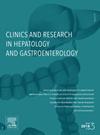Glucocorticoids accelerate the reduction of disease severity and biochemical parameters in drug-induced liver injury: Assess the causal relationship using the updated RUCAM scale
IF 2.4
4区 医学
Q2 GASTROENTEROLOGY & HEPATOLOGY
Clinics and research in hepatology and gastroenterology
Pub Date : 2025-06-07
DOI:10.1016/j.clinre.2025.102635
引用次数: 0
Abstract
Background
The efficacy and clinical application of glucocorticoids (GCs) in patients with drug-induced liver injury (DILI) remain controversial.
Aims
To determine the efficacy and suitable population of GCs in patients with DILI.
Methods
This was a single-center, retrospective study. Patients with moderate-to-severe DILI who met the diagnostic criteria from January 1, 2009 to December 31, 2024 were enrolled. Patients in the GC group and the non-GC group were matched 1:1 by propensity score-matched (PSM), and the reduction of disease severity and biochemical parameters were compared between the two groups. According to the level of TB, the patients with DILI were divided into three groups, and the efficacy of GCs in each subgroup was compared.
Results
Patients with DILI in our study were evaluated by the updated RUCAM causality assessment scale. All patients had RUCAM scores≥6 and causal relationship graded as " probable" or " highly probable". The use of GC treatment differs according to the severity of patients, especially the baseline level of TB ( % in patients with TB <5 ULN, % in patients with 5ULN≤TB≤10ULN, and % in TB≥10ULN). After PSM analysis, 163 patients were included in each group. After PSM, the time of severity reduction was faster in the GC group than the non-GC group (P = 0.022). The adjusted cumulative rate of severity reduction was 62 % in the GC group and 43.6 % in the non-GC group. The cumulative rates of reaching 50 % reduction in AST, ALP, TB level was higher in the GC group than in the non-GC group (P < 0.001, P = 0.0086 and P = 0.003). Patients were divided into three subgroups according to baseline TB level. We found the cumulative rates of who achieved severity reduction and 50 % reduction in liver biochemical parameters at discharge was higher in the GC group than in the non-GC group in patients with 5ULN≤ TB level ≤10ULN but not in patients with TB <5ULN and TB>10ULN. Multivariate analysis showed that sex, age, treatment group and severity were significantly associated with disease severity reduction of patients with DILI. After PSM, there were 56 patients with drug-induced autoimmune hepatitis (DI-AIH) and 270 patients with DILI with no autoimmune features cases in our cohort. The cumulative rate of severity reduction at discharge in the GC group was higher than that in the non-GC group in patients with DI-AIH (P = 0.049). Although the incidence of side effects in the GC group was higher than that in the non-GC group, the adverse reactions were basically relieved with the withdrawal of GCs.
Conclusions
GCs accelerated the reduction of disease severity and liver biochemical parameters, especially in patients with 5ULN≤baseline TB level≤10ULN. Sex, age, treatment group and severity were significantly associated with disease severity reduction of patients with DILI.
糖皮质激素加速降低药物性肝损伤的疾病严重程度和生化参数:使用更新的RUCAM量表评估因果关系
背景:糖皮质激素(GCs)在药物性肝损伤(DILI)患者中的疗效和临床应用仍存在争议。目的:确定GCs在DILI患者中的疗效和适用人群。方法:本研究为单中心回顾性研究。纳入2009年1月1日至2024年12月31日符合诊断标准的中重度DILI患者。采用倾向评分匹配法(PSM)对GC组和非GC组患者进行1:1匹配,比较两组患者疾病严重程度和生化指标的降低情况。根据结核水平将DILI患者分为三组,比较各亚组GCs的疗效。结果:本研究中DILI患者采用更新的RUCAM因果关系评估量表进行评估。所有患者的RUCAM评分均≥6,因果关系分级为“可能”或“极可能”。根据患者的严重程度,特别是TB 10ULN患者的TB基线水平(%),GC治疗的使用有所不同。多因素分析显示,性别、年龄、治疗组和严重程度与DILI患者疾病严重程度降低显著相关。PSM后,我们的队列中有56例药物性自身免疫性肝炎(DI-AIH)和270例无自身免疫性特征的DILI患者。DI-AIH患者出院时GC组的累计严重程度降低率高于非GC组(P=0.049)。虽然GC组的不良反应发生率高于非GC组,但随着GC的停药,不良反应基本缓解。结论:GCs加速了疾病严重程度和肝脏生化参数的降低,特别是在5ULN≤基线TB水平≤10ULN的患者中。性别、年龄、治疗组和严重程度与DILI患者疾病严重程度降低显著相关。
本文章由计算机程序翻译,如有差异,请以英文原文为准。
求助全文
约1分钟内获得全文
求助全文
来源期刊

Clinics and research in hepatology and gastroenterology
GASTROENTEROLOGY & HEPATOLOGY-
CiteScore
4.30
自引率
3.70%
发文量
198
审稿时长
42 days
期刊介绍:
Clinics and Research in Hepatology and Gastroenterology publishes high-quality original research papers in the field of hepatology and gastroenterology. The editors put the accent on rapid communication of new research and clinical developments and so called "hot topic" issues. Following a clear Editorial line, besides original articles and case reports, each issue features editorials, commentaries and reviews. The journal encourages research and discussion between all those involved in the specialty on an international level. All articles are peer reviewed by international experts, the articles in press are online and indexed in the international databases (Current Contents, Pubmed, Scopus, Science Direct).
Clinics and Research in Hepatology and Gastroenterology is a subscription journal (with optional open access), which allows you to publish your research without any cost to you (unless you proactively chose the open access option). Your article will be available to all researchers around the globe whose institution has a subscription to the journal.
 求助内容:
求助内容: 应助结果提醒方式:
应助结果提醒方式:


